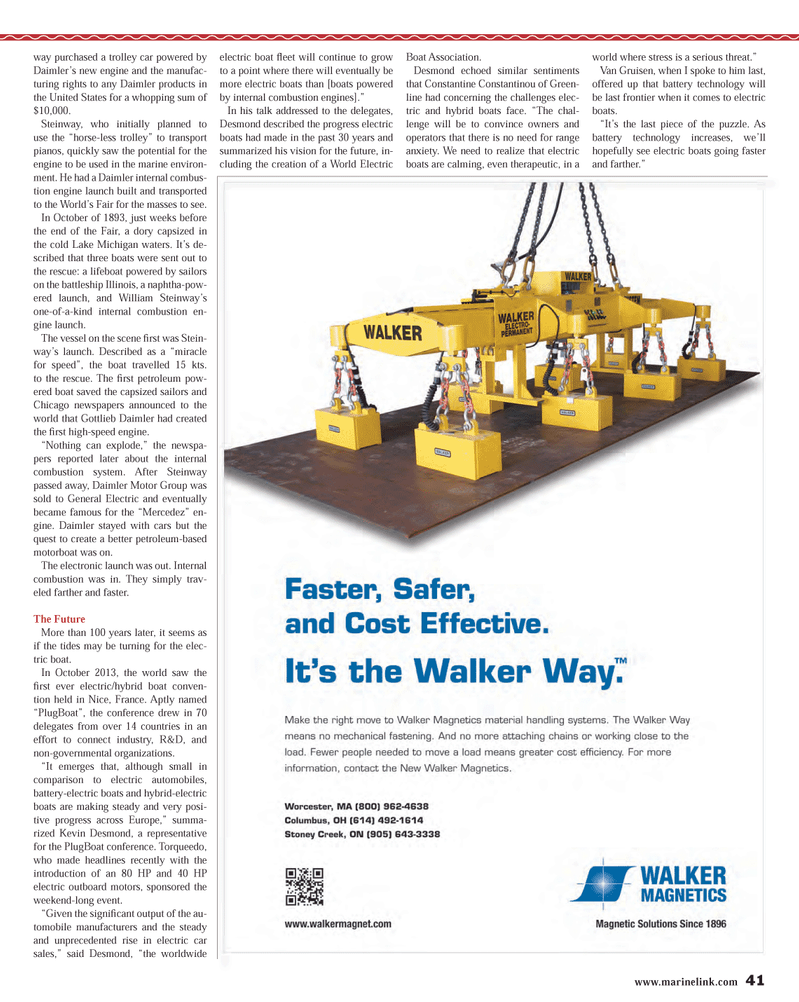
Page 41: of Maritime Reporter Magazine (November 2013)
Marine Propulsion Annual
Read this page in Pdf, Flash or Html5 edition of November 2013 Maritime Reporter Magazine
www.marinelink.com 41way purchased a trolley car powered by Daimler?s new engine and the manufac- turing rights to any Daimler products in the United States for a whopping sum of $10,000. Steinway, who initially planned to use the ?horse-less trolley? to transport pianos, quickly saw the potential for the engine to be used in the marine environ-ment. He had a Daimler internal combus-tion engine launch built and transported to the World?s Fair for the masses to see. In October of 1893, just weeks before the end of the Fair, a dory capsized in the cold Lake Michigan waters. It?s de- scribed that three boats were sent out to the rescue: a lifeboat powered by sailors on the battleship Illinois, a naphtha-pow-ered launch, and William Steinway?s one-of-a-kind internal combustion en-gine launch. The vessel on the scene Þ rst was Stein- way?s launch. Described as a ?miracle for speed?, the boat travelled 15 kts. to the rescue. The Þ rst petroleum pow- ered boat saved the capsized sailors and Chicago newspapers announced to the world that Gottlieb Daimler had created the Þ rst high-speed engine. ?Nothing can explode,? the newspa-pers reported later about the internal combustion system. After Steinway passed away, Daimler Motor Group was sold to General Electric and eventually became famous for the ?Mercedez? en-gine. Daimler stayed with cars but the quest to create a better petroleum-based motorboat was on. The electronic launch was out. Internal combustion was in. They simply trav- eled farther and faster. The Future More than 100 years later, it seems as if the tides may be turning for the elec-tric boat.In October 2013, the world saw the Þ rst ever electric/hybrid boat conven-tion held in Nice, France. Aptly named ?PlugBoat?, the conference drew in 70 delegates from over 14 countries in an effort to connect industry, R&D, and non-governmental organizations. ?It emerges that, although small in comparison to electric automobiles, battery-electric boats and hybrid-electric boats are making steady and very posi-tive progress across Europe,? summa-rized Kevin Desmond, a representative for the PlugBoat conference. Torqueedo, who made headlines recently with the introduction of an 80 HP and 40 HP electric outboard motors, sponsored the weekend-long event. ?Given the signiÞ cant output of the au- tomobile manufacturers and the steady and unprecedented rise in electric car sales,? said Desmond, ?the worldwide electric boat ß eet will continue to grow to a point where there will eventually be more electric boats than [boats powered by internal combustion engines].?In his talk addressed to the delegates, Desmond described the progress electric boats had made in the past 30 years and summarized his vision for the future, in-cluding the creation of a World Electric Boat Association. Desmond echoed similar sentiments that Constantine Constantinou of Green-line had concerning the challenges elec-tric and hybrid boats face. ?The chal-lenge will be to convince owners and operators that there is no need for range anxiety. We need to realize that electric boats are calming, even therapeutic, in a world where stress is a serious threat.?Van Gruisen, when I spoke to him last, offered up that battery technology will be last frontier when it comes to electric boats. ?It?s the last piece of the puzzle. As battery technology increases, we?ll hopefully see electric boats going faster and farther.? MR #11 (34-41).indd 41MR #11 (34-41).indd 4111/11/2013 12:05:29 PM11/11/2013 12:05:29 PM

 40
40

 42
42
